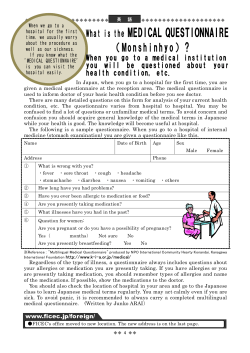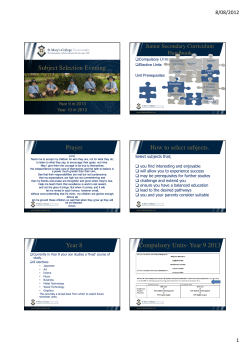
3 How to Approach the Written Examination During the year Topics
The Leading Edge – VCE Japanese Second Language
3 How to Approach the Written Examination
During the year
Outlined below are a number of things you need to focus on during the year.
Topics
Your teacher will provide you with course outlines for Units 1–4, which include sub-topics that
should cover all the prescribed themes and topics. Refer to the list on page 3.
Vocabulary
A Vocabulary List is provided on the VCAA website. You will be expected to know all the
Japanese words on this vocabulary list. The written exam may include words that are not in
this list. If this is the case, the English meaning of the words will be given.
Grammar
pa
ge
s
Ask your teacher for a copy of the detailed list of grammar items in the Study Design,
pages 15–21. You will be expected to recognise and use all the grammar items on this list.
Prescribed kanji
You will be expected to be able to read and write correctly the active use kanji and recognise
and understand the recognition only kanji listed below.
For active use
-"s#
counters
_
seasons/time
V1yU\kh^/ZHX
2%$f]YW5'
parts of the body
family
adjectives
verbs
t)|O
+EMa&!3
Sa
positions/directions
m
pl
e
numbers
le:>T
6?9=R*4@cdI
`nzN[
0
vu}GPL
school life
<bQ;
nature
ACoBj7
miscellaneous
(xp8{giFD
.qrw~m,J K
S
16
The Leading Edge – VCE Japanese Second Language
Recognition only
family
verbs
,
miscellaneous
.!(-)"21#
0'$
%
colours
+/&3*
repeat sign
Japanese Second Language Victorian Certificate of Education Study Design, Victorian Curriculum and
Assessment Authority 2004, page 14.
Assessment Criteria
Text types
pa
ge
s
The most up-to-date list of the Assessment Criteria for the written exam is provided
in the VCAA Bulletin and the VCE LOTE Assessment Handbook. The handbook can
be found on the VCAA website.
Questions in the written exam may ask you to produce the text types listed below. The
complete list of text types that you are expected to be familiar with is in the Study Design,
page 13. Characteristics of some of these text types are also available from the Study
Design. Ask your teacher for a copy of this information.
essay
biography
extended caption
brochure
fax
conversation
news item
review
personal account
speech (script)
pl
e
article
story
invitation
personal profile
summary
discussion
journal entry
report (repooto)
email
message
report (hookokusho)
Sa
Kinds of writing
m
personal letter
Descriptions of the main characteristics of five different kinds of writing (personal,
imaginative, persuasive, informative and evaluative) are in the Study Design, pages 67–68.
An understanding of these characteristics is particularly helpful when answering Section 3 of
the written exam.
You and your dictionary
Your dictionary can be both your best friend and your worst enemy. It depends on when and
how you use it.
•
So that you become familiar with your dictionary, use it regularly throughout the year.
•
Usually, you will find several Japanese words under one English word. Learn to select
an appropriate word.
•
In the exam, don’t waste time looking up individual words if you understand the
meaning of a sentence.
•
You can take monolingual and/or bilingual dictionaries into the exam.
•
You are not allowed to take a dictionary into the exam if it has been written in, so do
not make notes in your dictionary.
17
The Leading Edge – VCE Japanese Second Language
Exam preparation throughout year
•
•
•
•
You need to develop exam skills. Look at as many past exams as possible and practise
responses. Reflect and act on any feedback you are given.
Practise completing exam tasks within the suggested time.
Practise writing a range of pieces throughout the year to prepare for the Japanese
essay question.
When you practise a listening task, focus on using the note-taking spaces to help you
use them effectively in the exam.
Reading comprehension
pa
ge
s
You will need to develop your reading comprehension skills for the reading and responding
section of the exam. To improve your reading comprehension skills:
•
read a wide variety of texts to familiarise yourself with as many different topics as
possible
•
practise identifying key points of the short texts you read
•
practise reorganisation and summarising exercises. For example, read a passage and
rewrite it in your words. These skills are particularly useful for Section 2: Part B
•
use your dictionary effectively.
The final weeks
•
•
•
Regularly practise listening tasks.
Read anything you can obtain in Japanese. The texts in the exam are not long, so read
a range of short texts and see if you can understand them.
Do a quick revision of grammar points.
Reread your written pieces and your teacher’s comments.
Practise writing tasks for Section 3 of the exam within 50 minutes.
pl
e
•
•
written exam is designed to assess your knowledge and skills in:
analysing and responding to information from spoken texts
analysing and responding to information from written texts
expressing ideas through the creation of original texts written in Japanese.
Sa
The
•
•
•
m
The exam itself
In order to assess these skills, the exam is divided into three sections. The first two sections
are themselves divided into two parts (A and B).
Section 1
Listening and responding
Part A: Listening and responding in English
Part B: Listening and responding in Japanese
Section 2
Reading and responding
Part A: Reading and responding in English
Part B: Reading and responding in Japanese
Section 3
Writing in Japanese
The duration of the written exam is 2 hours plus 15 minutes reading time.
You should familiarise yourself with the purpose and specifications of each section of the
exam by reading the Study Design, pages 36–37. Ask your teacher for a copy of these pages
from the Study Design.
18
The Leading Edge – VCE Japanese Second Language
Reading time
•
•
•
•
Make effective use of reading time.
Read the whole paper.
Read all the tasks in Section 3: Writing in Japanese, and choose the topic you intend to
write about.
Read Section 1: Listening and responding again. Concentrate on the questions. It is
very important that you know what to listen for before the recording starts.
Section 1 – Part A: Listening and responding in English
You will hear 2–3 short texts played in Japanese. Each text will be played twice and you will
be expected to respond in English to questions that are also written in English.
Ask your teacher for a copy of page 36 from the Study Design, so you can read the detailed
specifications for this section.
m
pl
e
pa
ge
s
In the exam:
•
Remember you must answer Part A in English.
•
The audio CD will be played non-stop and each text will be heard twice. There will be a
pause between the first and the second readings to allow you to take notes. You will
then be given time after the second reading to complete your responses.
•
Before answering a question, check the number of marks that has been allocated to it.
The marks will give you an idea of the length and amount of detail expected in your
answer.
•
Do not write everything you understand from the recorded text. You must give succinct
and relevant answers to the questions.
•
Use the note-taking space. You should jot down relevant information in English or
Japanese as you listen to the text in the first and second readings. When you hear
words or expressions that you do not understand, you should try to write them in
correct Japanese. You will not be able to find the meaning of a word in your dictionary
if you misspell it.
Sa
Below are two sample listening tasks. To do these tasks you will need to listen to Tracks 1
and 2 on Audio CD 1, which is in the back of this Exam Success Guide. You will find
transcripts and answers for all the sample tasks in Chapter 4.
Sample 1 (Listening and responding in English)
Question 1
Give three reasons why Kenji is hesitant about attending the formal.
•
•
•
3 marks
19
Space for making notes.
The Leading Edge – VCE Japanese Second Language
Question 2
What does Kate first suggest about Kenji’s clothes for the formal?
Space for making notes.
2 marks
Question 3
What is the problem with this arrangement?
2 marks
s
Question 4
What have they finally decided to do?
pa
ge
2 marks
Sample 2 (Listening and responding in English)
Sa
m
pl
e
Question 1
Why does Mike want to go to Sapporo?
2 marks
Question 2
When does Mike plan to go to Sapporo and when will he return to
Tokyo?
2 marks
Question 3
When does the Snow Festival begin?
1 mark
Question 4
Why didn’t Mike see the festival when he last visited Sapporo?
1 mark
20
Space for making notes.
The Leading Edge – VCE Japanese Second Language
Section 1 – Part B: Listening and responding in Japanese
You will hear 1–2 short texts played in Japanese. Each text will be played twice and you will
be expected to respond in Japanese to questions written in both English and Japanese.
Ask your teacher for a copy of page 36 from the Study Design, so you can read the detailed
specifications for this section.
pa
ge
s
In the exam:
•
You must answer in Japanese. Answers in English will not be given any marks.
•
The audio CD will be played non-stop and each text will be heard twice. There will be a
pause between the first and the second readings to allow you to take notes. You will
then be given time after the second reading to complete your responses.
•
Before answering a question, check the number of marks that has been allocated to it.
The marks will give you an idea of the length and amount of detail expected in your
answer.
•
Take notes in Japanese. This does not mean writing everything you understand from
the recorded text. Take down only information you need to answer the questions later.
Making notes in Japanese saves time and allows you to write down appropriate and
accurate Japanese sentences and/or phrases.
•
You must use the VCE prescribed kanji in your responses. Misspelling of the script,
including hiragana and katakana, and grammatical errors will result in the deduction of
marks.
pl
e
Below are two sample listening tasks. To do these tasks you will need to listen to Tracks 3
and 4 on Audio CD 1, which is in the back of this Exam Success Guide. Check your answers
in Chapter 4.
m
Sample 3 (Listening and responding in Japanese)
Sa
Question 1
Ben is asked to talk about his part-time job in class.
Complete the following passage using his speech.
8<.:0,;5-3F$!(!
8<061*">D*
+
8<+
,;5-3*!
,;5-38<+
*
*+&!
#927/<"
C&!
=@?4;
AEB
"%!
,;5-3+
)'+
!%
+
*(%
21
Space for making notes.
The Leading Edge – VCE Japanese Second Language
Sample 4 (Listening and responding in Japanese)
Question 1
List two problems Sue experienced while Yoshiko stayed at her house.
&# '
Space for making notes.
1
Sa
m
pl
e
pa
ge
Question 2
What advice did Sue give Toshio?
!"%
$'
s
2
22
The Leading Edge – VCE Japanese Second Language
Section 2 – Part A: Reading and responding in English
You will be expected to read 1–2 short texts in Japanese and respond in English to questions
that are also written in English.
Ask your teacher for a copy of the Study Design, pages 36–37 so you can read the detailed
specifications for this section.
In the exam:
•
Always thoroughly read the questions before reading each text.
•
The first time you read each text, read it all the way through to make sure you
understand the gist of the text.
•
When reading the text for the second (or third) time, underline the words, expressions
or sentences that give you the answers to the questions.
•
Do not summarise the texts unless the question specifically asks you to do so.
•
Write only succinct and relevant answers to the questions.
Sample 5 (Reading and responding in English)
s
Space for making notes.
pa
ge
B;=gV
y kt$B;=gVT643B;=T
%.$2
R"!cO3WR73L88
'
3 B;=9E;A$-58R#C<G
pJouJ
$!-3
Sa
m
pl
e
y XQB;=#,!55 -#_iP!
B;=l43H:=FIR."/!
b[3#cO3B;=#:=H:
/#,#( 88-3*L#f!
R."7_\$hx7YN1
B;=7S33
y #B;=@D#f#^M-8-_
v3jq#pOZ-'
.Q`#R
-)
3T8! 3 y +$R."$ 1L#f3c$
a W#0!B;=?>-n 1
Ld#b(#27b(W$]r#Z-#
0!63ce
y R."!#8
s#0!6
#$5.$2kt#aZK .UwK !
83#5Z-a L
m&135c'
15
Notes:
aZK/y increase in few-children families
UwK4y increase in aging population
23
The Leading Edge – VCE Japanese Second Language
Space for making notes.
Question 1
List three recent developments affecting pet ownership in Japan.
•
•
•
3 marks
pa
ge
s
Question 2
Explain how Japanese people have changed their attitudes towards dogs
and cats.
4 marks
pl
e
Question 3
What are the problems caused by this pet boom?
Sa
•
m
•
2 marks
Question 4
What do you think are the causes of the recent pet boom in Japan?
•
•
2 marks
24
The Leading Edge – VCE Japanese Second Language
Section 2 – Part B: Reading and responding in Japanese
You will be expected to read 1–2 short texts in Japanese and respond in Japanese to
questions that are written in both English and Japanese.
Ask your teacher for a copy of the Study Design, pages 36–37 so you can read the detailed
specifications for this section.
pa
ge
s
In the exam:
•
always thoroughly read the questions both in English and Japanese before reading
each text
•
the first time you read each text, read it all the way through to make sure you
understand the gist of the text
•
when reading the text for the second (or third) time, underline the sentences or
expressions that give you the answers to the questions
•
do not summarise the texts unless the question specifically asks you to do so
•
write only succinct and relevant answers to the questions.
•
you must use the VCE prescribed kanji in your responses. Misspelling of the script,
including hiragana and katakana, and grammatical errors will result in the deduction of
marks.
Sample 6 (Reading and responding in Japanese)
KCDLMFTQ
pl
e
*?}$6.% #=z_thgt@:
e3??'PBIMPNAA(
m
=~_A*b78$[|=na
<3A*q
7HVOSJGR
{
'&+ !#^$/%p''<3
Sa
A'z$vd*=ykhg*utKCDLM
FTQ@!<3
*FTQ(~<t%+x80A:<EU
Xq$A('<%fbYl'>,
'<3A#]w*9<96-!:$
+5*ZWc+3%6**2+\$6
r1;>3<9<(/;@j #+3A
#o(iAA'x@3
*FTQ(~ #;EU67=t%+
%8$75' 4A'$';
;3$!"=%$x6
` %f #3*t%*]w6s
rm*_1#: $
*FTQ@! ut+7=5$+'
t%9!3$6A'x$=:(%
) #KCDLMFTQ@! $
25
Space for making notes.
The Leading Edge – VCE Japanese Second Language
Space for making notes.
s
Question 1
Why does a student who wants to be a member of this club need his
family’s cooperation? Use the text to present your viewpoint.
,
"!*
%(
&-'
5 marks
pa
ge
Question 2
List two benefits of being a member of the club.
"!$)'
•
•
pl
e
3 marks
m
Question 3
What is the most important purpose of this club?
"!#+$
Sa
2 marks
26
The Leading Edge – VCE Japanese Second Language
SECTION 2 – Reading and responding
Instructions for Section 2 – Part A
Texts 5 and 6, Questions 13–18
•
Read the text and then answer the questions in ENGLISH.
•
All answers must be based on the text.
TEXT 5 – Answer the following questions in ENGLISH.
Responses in the wrong language will receive no credit.
Space for making notes.
(1
!77
pride
responsibility
m
Notes:
pl
e
pa
ge
s
c ^a"5+"#*0'5
*#(7"5+"#TR,]J6Y0
BF=9C#0M-. 8FA9?625+"&2"[6
BE=PBE=#K \L2
$1# +02
NZ \L
7 0;G<>?:@6U1OS0
N611 )1XI"7/ c 3+BE="[Q&2"#
4M"5+"#VW/1G<D"`
0
c 3!
_7"/!H"IXH\#0
#Z VW62(1,!77+Z )JRIXXI"+%2
05+"#5"+3 .b
BF=9C#0[Q#+Z 24
Sa
Question 13
Explain the meaning of Freetar.
2 marks
SECTION 2, Part A – continued
61
The Leading Edge – VCE Japanese Second Language
Question 14
What are five disadvantages of being a Freetar?
Space for making notes.
•
•
•
•
•
5 marks
Question 15
List five reasons why the number of Freetars in Japan is increasing?
•
s
•
pa
ge
•
•
•
5 marks
Sa
m
pl
e
SECTION 2, Part A – continued
62
The Leading Edge – VCE Japanese Second Language
Space for making notes.
TEXT 6 – Answer the following questions in ENGLISH.
Responses in the wrong language will receive no credit.
[ L HG,&':=4,
!6AES! 39 '!
IJ
M ?38<@1208?3!'JM
*JM PUVC"
)'L
Y$:=4R
T:=4 OW
%NB
TF
)++
JM
-)K!
[ L &Z.7/38)
%#5@3
?63@$XP!:>40; ''OW
FM
C"
('
$')D Q**'$:=4,)
$(
pa
ge
s
Question 16
What does the writer like about her current job?
pl
e
1 mark
Question 17
What has this writer done so far? What does the writer want to do in the
future?
3 marks
•
•
Sa
•
m
Question 18
List four advantages of being a Freetar instead of having full-time work.
•
4 marks
Total 20 marks
End of SECTION 2, Part A
63
The Leading Edge – VCE Japanese Second Language
Instructions for Section 2 – Part B
Text 7, Questions 19–21
•
Read the text and then answer the questions in JAPANESE.
•
All answers must be based on the text.
Space for making notes.
TEXT 7 – Answer the following questions in JAPANESE.
Responses in the wrong language will receive no credit.
e L#a$\D"Q)$+^"!1\D#AO
8=9;7#JM51L$TN/ \D"
Q61/!"Q6 !
!
e VacXH#!"Q61/^">$
A"G\D$&60Vac#@"G !"Q6)!1 %#@$2!"4
pa
ge
s
!0WER#U,6Vc
_b"GN,]6!C,B
pl
e
Va 050I"6'"G01
e >d[A"$6AO1/JM5
F-W`?1/
,`C"!,
"G1<:-ZP,6&60
([A#Y$!#Y.0
,3 [A,!,
K4U$[A"Q)3
•
•
•
Sa
•
m
Question 19
Give four positive reasons for living in the country.
!"Q*#6"S!
Question 20
Give four positive reasons for living in the city.
[A"Q*#6"S!
•
•
•
•
SECTION 2, Part B – continued
64
The Leading Edge – VCE Japanese Second Language
Space for making notes.
s
Question 21
What is your opinion of living in the city or country? Write your answer
in approximately 50 ji. Use the information in the text to support your
opinion.
'!&"#$
%( %
pa
ge
Total 10 marks
Sa
m
pl
e
End of SECTION 2, Part B
65
© Copyright 2025









